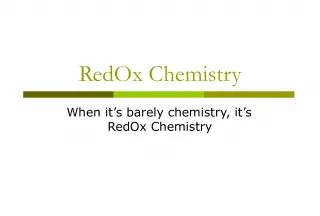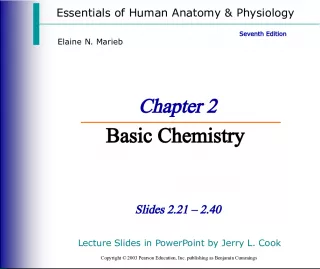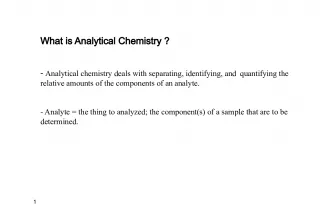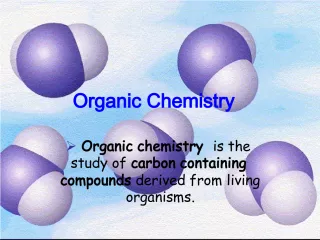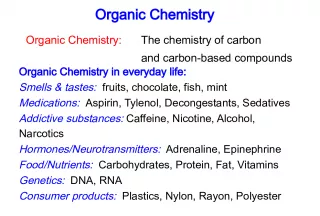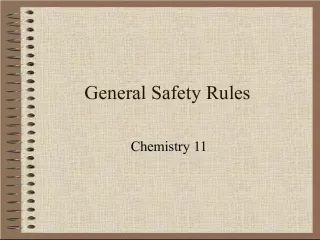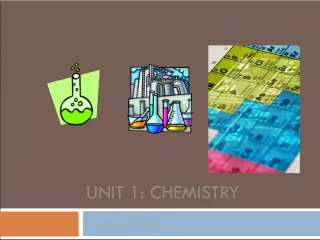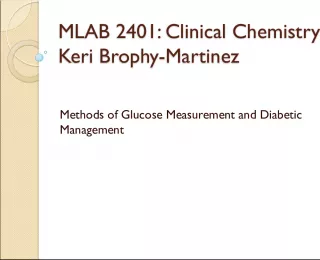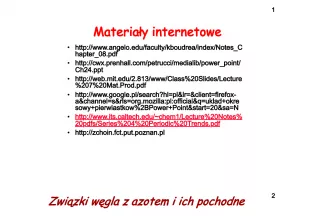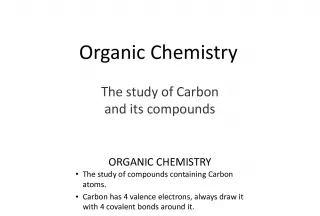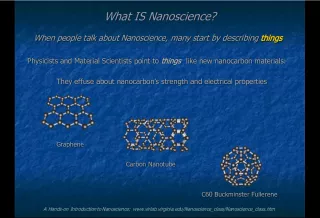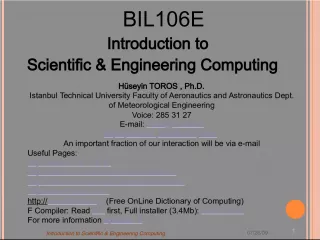Introduction to Stoichiometry in Chemistry


Learn about stoichiometry, the branch of chemistry that investigates the quantities of reactants and products in chemical reactions. This includes understanding balanced chemical equations, interpreting quantities in terms of atoms, molecules, and moles, and applying the law of conservation of mass.
- Uploaded on | 0 Views
-
 lee
lee
About Introduction to Stoichiometry in Chemistry
PowerPoint presentation about 'Introduction to Stoichiometry in Chemistry'. This presentation describes the topic on Learn about stoichiometry, the branch of chemistry that investigates the quantities of reactants and products in chemical reactions. This includes understanding balanced chemical equations, interpreting quantities in terms of atoms, molecules, and moles, and applying the law of conservation of mass.. The key topics included in this slideshow are stoichiometry, chemistry, reactants, products, balanced chemical equation, atoms, molecules, moles, conservation of mass,. Download this presentation absolutely free.
Presentation Transcript
2. Stoichiometry is the part of chemistry that studies amounts of reactants and products that are involved in reactions. Chemists use a balanced chemical equation as a basis to calculate how much reactant is used or product that is produced in a reaction. A balanced chemical equation can be interpreted in terms of different quantities, including number of atoms , molecules , or moles .
3. In a balanced chemical equation, the coefficient in an equation represents not only numbers of individual molecules but also numbers of moles . The basis for stoichiometry is the law of conservation of mass, which states the mass of the reactants will equal the mass of the products.
4. 2 Cr + 1 Mm + 3 Ch 1 Cr 2 MmCh 3
5. Balance the equation. ____N 2 + ____H 2 ____NH 3 This equation can be looked at with ________ molecule of N 2 reacts with __________ molecules of H 2 to produce two ________________ of NH 3 . 1 3 2 one three molecules
6. 1 N 2 + 3 H 2 2 NH 3 This equation can be looked at as one mole of N 2 reacts with three ____________ of H 2 to produce _________ moles of NH 3 . moles two
7. A mole ratio is a _______________ factor derived from the ______________ of a balanced chemical equation interpreted in terms of ______________. conversion coefficients moles Find Given
8. Balance the equation and write all six mole ratios. ____Fe + ____O 2 ____Fe 2 O 3 4 3 2 4 Fe 3 O 2 4 Fe 2 Fe 2 O 3 2 Fe 2 O 3 3 O 2 4 Fe 3 O 2 3 O 2 2 Fe 2 O 3 2 Fe 2 O 3 4 Fe
9. 1. Balance the equation 2. Identify given and finish line 3. Use mole ratio and/or molar mass to solve 4. Check sig. figs. and round if needed
11. C 6 H 12 O 6 + O 2 CO 2 + H 2 O 1 6 6 6 2.00 mol C 6 H 12 O 6 6 mol CO 2 1 mol C 6 H 12 O 6 = 12.0 mol CO 2
12. H 2 + N 2 NH 3 8.50 mol H 2 2 mol NH 3 3 mol H 2 = 5.67 mol NH 3 3 2 1
14. Al + HCl AlCl 3 + H 2 2 3 2 6 6.000 mol Al 3 mol H 2 2.02 g H 2 2 mol Al 1 mol H 2 = 18.18 g H 2
15. Al + HCl AlCl 3 + H 2 2 3 2 6 4.00 mol HCl 2 mol AlCl 3 133.33 g AlCl 3 6 mol HCl 1 mol AlCl 3 = 178 g AlCl 3
16. C 8 H 18 + O 2 CO 2 + H 2 O 2 18 16 25 325 g C 8 H 18 1 mol C 8 H 18 18 mol H 2 O 114.26 g C 8 H 18 2 mol C 8 H 18 = 25.6 mol H 2 O
17. C 8 H 18 + O 2 CO 2 + H 2 O 2 18 16 25 145 g O 2 1 mol O 2 16 mol CO 2 32.00 g O 2 25 mol O 2 = 2.90 mol CO 2
19. C 5 H 12 + O 2 CO 2 + H 2 O 1 6 5 8 100.0 g C 5 H 12 1 mol C 5 H 12 5 mol CO 2 44.01 g CO 2 72.17 g C 5 H 12 1 mol C 5 H 12 1 mol CO 2 = 304.9 g CO 2
20. Zn + HNO 3 Zn(NO 3 ) 2 + N 2 O + 5 H 2 O 4 1 4 10 8.75 g N 2 O 1 mol N 2 O 10 mol HNO 3 63.02 g HNO 3 44.02 g N 2 O 1 mol N 2 O 1 mol HNO 3 = 125 g HNO 3
21. N 2 + H 2 NH 3 1 2 3 5.40 g H 2 1 mol H 2 2 mol NH 3 17.04 g NH 3 2.02 g H 2 3 mol H 2 1 mol NH 3 = 30.4 g NH 3

